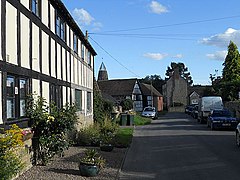Culmington
| Culmington | |
|---|---|
 Culmington, Shropshire |
|
| Culmington shown within Shropshire | |
| Population | 423 (2011 Census) |
| OS grid reference | SO490820 |
| Civil parish |
|
| Unitary authority | |
| Ceremonial county | |
| Region | |
| Country | England |
| Sovereign state | United Kingdom |
| Post town | LUDLOW |
| Postcode district | SY8 |
| Dialling code | 01584 |
| Police | West Mercia |
| Fire | Shropshire |
| Ambulance | West Midlands |
| EU Parliament | West Midlands |
| UK Parliament | |
| Website | culmington.org |
Culmington is a small village and civil parish in south Shropshire, England.
The nearest towns are Craven Arms and Ludlow. The village is situated just off the B4365 road, north of Stanton Lacy.
The River Corve flows just to its east. The village lies at around 100m above sea level.
In the 19th century, Culmington was described as:
At the time of the Domesday Book (1086) the parish was located within the hundred of Culvestan. The Book recorded that at the time the manor of Culmington belonged to Earl Roger of Shrewsbury at an estimated price of £6. The area was entrusted to the Earl by his cousin, King William. There were said to be 12 villagers, with a total of 4 slaves within the parish. Prior to the control of the Earl, the area of Culmington and much of the Shropshire county belonged to Edric the Wild. He is reputed to have held the Welsh border with a heavy hand. The Domesday Book records the name as 'Comintone'. The Saxon border Thane, Edric the Wild, held the areas of Sireton, Comitome and Elsich. Known today as Serifton, Culmington and Elsich respectively. The Saxon hundred of Culvestan was replaced in the reign of Henry I by the hundred of Munslow, which Culmington then became part of.
The names of Culmington and the hundred of Culvestan are similar but it is not clear whether the two share a common toponymy, with Culmington's name possibly deriving from "the estate of Cuthhelm". The meaning of the first element of Culvestan is also not certain, and may derive from another personal name, possibly Cuthwulf. The Domesday Book recorded two slightly different spelling variants of the hundred's name – twice as Colmestan(e) and once as Comestane – which are more similar to Culmington (which was spelled as Comintone). However this is believed to be the possible result of assimilation to the name of Culmington by the scribe.
...
Wikipedia

